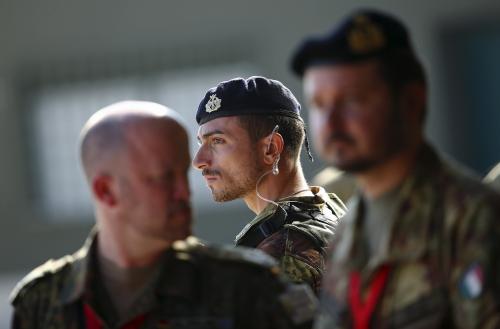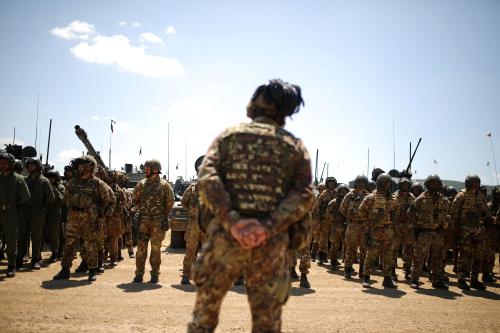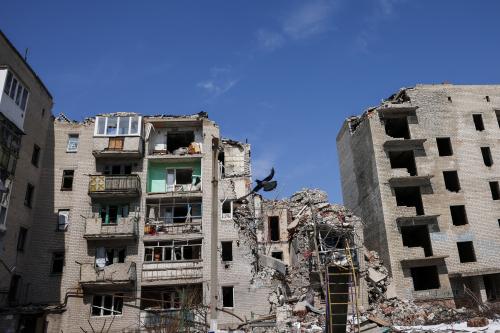The alleged rape of a 12-year-old Japanese girl by U.S. servicemen stationed in Okinawa has revealed a fragility in the U.S.-Japan alliance that most policymakers in Tokyo and Washington are reluctant to recognize. The incident last fall and the strong Japanese reaction to it should be the wake-up call that prompts a rethinking of the U.S.-Japanese security relationship before even more serious damage is done.
Okinawans have long felt unfairly burdened by the U.S. military presence in Japan. Japan’s smallest and poorest prefecture, Okinawa houses about three- fourths of the U.S. military facilities and two-thirds of the 45,000 American troops in Japan. Roughly 20,000 of the 29,000 troops on Okinawa are Marines. Artillery firings, low-flying aircraft, and other military exercises disrupt Okinawans’ daily lives, as do the thousands of crimes committed by U.S. soldiers since 1972, when Okinawa was formally returned to Japan by the United States after 27 years of occupation.
Okinawaþs governor, Masahide Ota, was elected in November 1990 on a reformist platform calling for a reduction in U.S. bases in Okinawa. Unlike many other Okinawan leaders pursuing that goal, however, Ota has sought to make adjustments within the alliance framework, not to abrogate the bilateral security treaty itself. But neither Tokyo nor Washington has heeded Otaþs agenda.
When the Pentagon released its East Asia-Pacific strategic review in February of 1995, it committed the United States to maintain 100,000 troops in the Asian-Pacific theater, including the 45,000 in Japan. The theater-wide total is down about a quarter from levels of the 1980s, partly because of the U.S. withdrawal from the Philippines, but the total based in Japan is down only 10 percent. In light of the Pentagon’s decision, Japanese defense officials saw no need for significant changes in the Okinawan base configuration.
Policymakers in both countries have greatly underestimated both the discontent among Okinawans and the resolve of Governor Ota. Roughly 85,000 Okinawans took part in a protest against U.S. military bases last October, and more than half a million have signed petitions calling for changes in the bilateral security arrangement. Governor Ota has refused to sign an executive order to force landowners to lease their property for American military use.
Tokyo and Washington are trying to ease current tensions by signing side letters to the Status of Forces agreement to enable Japan to request that U.S. military defendants in murder, rape, and other serious cases be turned over to Japanese custody before a formal indictment. The two governments have also established a joint committee to review U.S. bases in Japan with an eye toward consolidating some of the Okinawa military facilities. These measures were designed to give then Prime Minister Tomiichi Murayama the political cover he needed to take Governor Ota to court to compel the renewal of the land leases.
But the compromise will not satisfy Okinawa and may even aggravate matters. The Clinton administration is publicly standing firm against substantial cuts in the number of soldiers deployed in Japan. But to maintain existing troop levels while responding meaningfully to Ota’s call for fewer bases in Okinawa, the Pentagon would have to transfer some U.S. forces and facilities to Japan’s main islands. And residents in most potential transfer sites are adamantly opposed.
If the Okinawa problem spreads to the rest of Japan, it could undermine national support for the alliance. Recent public opinion polls show growing Japanese opposition to the U.S. military presence. For example, an Asahi Shimbun survey conducted late last October (see table 1) found that 76 percent of Japanese favor gradually reducing U.S. bases in Okinawa while 14 percent want their immediate removal. Only 7 percent support the status quo. According to the same poll, 58 percent oppose moving the U.S. bases in Okinawa to the main islands. Only 28 percent approve.
Especially worrisome is the drop in the number of Japanese who believe that the U.S.-Japan Security Treaty serves Japan’s interest. Fifty-two percent thought so in April 1992, but only 42 percent felt that way last October. In that same interval, those feeling the treaty does not serve Japan’s interests climbed from 21 percent to 28 percent. In the new political climate, politicians, even those who are traditionally strong American supporters, are increasingly reluctant to speak out on behalf of the alliance.
Before canceling his November trip to Japan because of the budget deadlock in Washington, President Clinton had planned to issue a joint declaration with Murayama in Tokyo on the allianceþs critical role in shaping post-Cold War regional stability and global security. The statement was to have capped a nearly year-long review of the security relationship by Japanese and American defense officials. The Okinawa base controversy has certainly soured the atmosphere for such a declaration.
By the time Clinton visits Tokyo in April and meets with the new prime minister, Ryutaro Hashimoto, he will have to give more than lip service to the notion of restructuring the alliance in response to changes in the international environment. Rather than sticking stubbornly to the status quo, the president should take a hard look at the U.S. force structure in Japan. One thing he would discover is that although Okinawa would still be a convenient place to keep some of their materials and infrastructure, 20,000 U.S. Marines are no longer needed there.
Military Considerations
The Okinawa-based Marines are not central to the U.S.-Japanese security relationship or the U.S. role in Asia more generally. The Marines on Okinawa, for example, are poorly suited to make rapid deployments to places such as South Korea. The four U.S. amphibious ships homeported nearby in Sasebo, Japan, can carry only about 3,000 troops and associated equipment. Any more amphibious ships would have to come from the United States, defeating much of the benefit of having the Marines on Okinawa. Marines could also deploy from Okinawa on commercial ships or planes. But commercial ships would need to be rented and are slower to load and unload than amphibious vessels. And planes, with their limited capacities, are best suited to transporting personnel and modest amounts of specialized equipment such as munitions, attack helicopters, and Patriot missile- defense systems. Marine equipment afloat in Guam would be quickly available, but because of the ease and speed of airlifting troops, it could be manned by Marines from anywhere.
Thus, Marines in Okinawa would provide only about 5 percent of early- arriving U.S. forces. Most U.S. defenders of South Korea would consist of the 37,000 Army and Air Force troops already in Korea, roughly 20,000 Air Force and Navy troops in Japan, or reinforcements from the United States.
Moreover, the Korean military balance is constantly improving in favor of the South. Although continued U.S. vigilance and commitment there remain important, the peninsula is probably exerting too great an influence over U.S. strategic planning. It should not be the principal determinant of how the United States configures forces that are not even at the core of U.S. capability for that theater. Les Aspin made this point compellingly as chairman of the House Armed Services committee, arguing in his 1992 “options” paper that the United States could probably limit its main contribution during any future Korean war to airpower.
Similar arguments would apply to other scenarios of land combat in Asia, such as trouble between Japan and Russia. The Marine force on Okinawa is too small for major combat engagements and generally too immobile even for establishing tripwires or slowing down an adversary in the early phases of an attack.
Marines are simply not the right instrument of military force for addressing possible Chinese threats to the Spratly Islands, Taiwan, or the sea lanes of the South China Sea. Marines are configured to fight in coastal regions and on land. The Navy and Air Force are better able to provide the high-performance fighter aircraft, bombers, submarines, and surface warfare ships needed for the blue-water engagements that such scenarios involving China would likely entail.
Okinawa is a convenient base from which to conduct routine Marine patrols in the Western Pacific. Such patrols, typically involving about 2,000 troops on three to five ships and conducted by so-called Marine Expeditionary Units, are maintained by Okinawan-based Marines. They conduct port calls and joint exercises with other countries’ forces and provide a small rapid-response capability for crises. But other Marines begin and end routine overseas patrols from the continental United States, and the Marines now in Okinawa could too.
At worst, if all Marine units were based in the United States, there might be longer gaps between successive patrols overseas. The usual six-month rotations at sea would include a month in trans-Pacific voyages in addition to the five months on station, making a decline in efficiency of about 15 percent. But the Navy and Marine Corps have already learned how to deal with gaps between successive deployments. They cover for each other, send different types of ships such as destroyers for routine presence missions, or get temporary help from the Army or Air Force if land basing is available in a given theater (as it often is for occasional deployments, even when other countries do not want a permanent U.S. presence on their soil). They could do so even more.
Moreover, if one wishes to focus on military efficiency, there is much to be said against keeping forces on Okinawa. Technically, Marines are not stationed there, they are temporarily deployed. Thus, to keep 20,000 Marines on Okinawa, perhaps twice that number must be kept in the active-duty force structure—a luxury we may no longer want to afford.
In the event that it brought forces home from Okinawa, the Marine Corps would have other options as well. It might, for example, maintain a continuous presence in the Pacific by placing less priority on its standard patrol in the Mediterranean, where the United States enjoys strong allies and a much improved geopolitical backdrop thanks to developments in the Middle East and the breakup of the Soviet Union. U.S. military access to NATO, Israeli, and Egyptian land bases in the area, though not to be taken for granted, is generally attainable when the lives of embassy personnel or other Americans might be at risk—perhaps the most compelling reason to have Marines on forward deployment and instantly available. Thus, Army special forces or light infantry units might take over this traditional Marine responsibility in the Mediterranean and allow sea-based forces to focus more attention on those regions where reliable land bases are not so plentiful.
As another option, the Marine Corps could borrow an idea from William Morgan, of the Center for Naval Analyses, and rotate crews by flying them from the United States to meet ships overseas. Doing so would obviate the need for long ocean voyages to and from the United States except when major ship repairs were needed. Indeed, Okinawa might be a rendezvous point where crews began and ended their shifts. Basing the 3rd Marine division at home would cost Washington more in annual operations and maintenance—about $1 billion as against half a billion dollars a year basing most of it in Japan. But those dollars would be spent in the United States, stimulating the economy and mitigating the pain of the ongoing military base closure process. Moreover, as suggested above, moving the Marines home might make it possible to reduce the overall size of the Corps if U.S. warfighting strategy changes, as many consider likely some time in the next year or two. In that event, there could even be net savings associated with the move.
Perceptions and Misperceptions
Moving the American Marines away from Okinawa, either to Hawaii or to the continental United States, would go far to defuse the current discontent in Okinawa and dramatically reduce the likelihood that it would recur there or elsewhere in Japan in the future.
Any perception abroad that the United States was disengaging from Asia would be countered not only by continued Marine patrols in the Western Pacific, but by the enduring presence of Army, Navy, and Air Force personnel in Japan and Korea. Japan would retain an important, yet less politically taxing, role in the U.S. Marine presence in the Pacific.
If the Marine pullout from Okinawa alarms any of Americas friends and allies in the Asia-Pacific, Washington should explore with them yet another possibility— deploying some Marine units to places like Darwin, Australia, and Pusan, Korea. Both, like Okinawa, are close to strategically important areas in Northeast and Southeast Asia (see table 2).
It is even possible that some Japanese may grow anxious at the prospect of the departure of U.S. ground forces. This reaction, more a matter of psychology than of military preparedness, may actually be a positive development, for it might push Japan toward a more realistic view of international security. A new Japan might then emerge—a country that defines its national interests in more than narrow economic terms and that is willing to assume the political and military risks necessary to preserve peace and security. Such an evolution would strengthen, rather than erode, what is still the most important bilateral security relationship in the world.



Commentary
The Marines Should Come Home: Adapting the U.S.-Japan alliance to a new security era
March 1, 1996